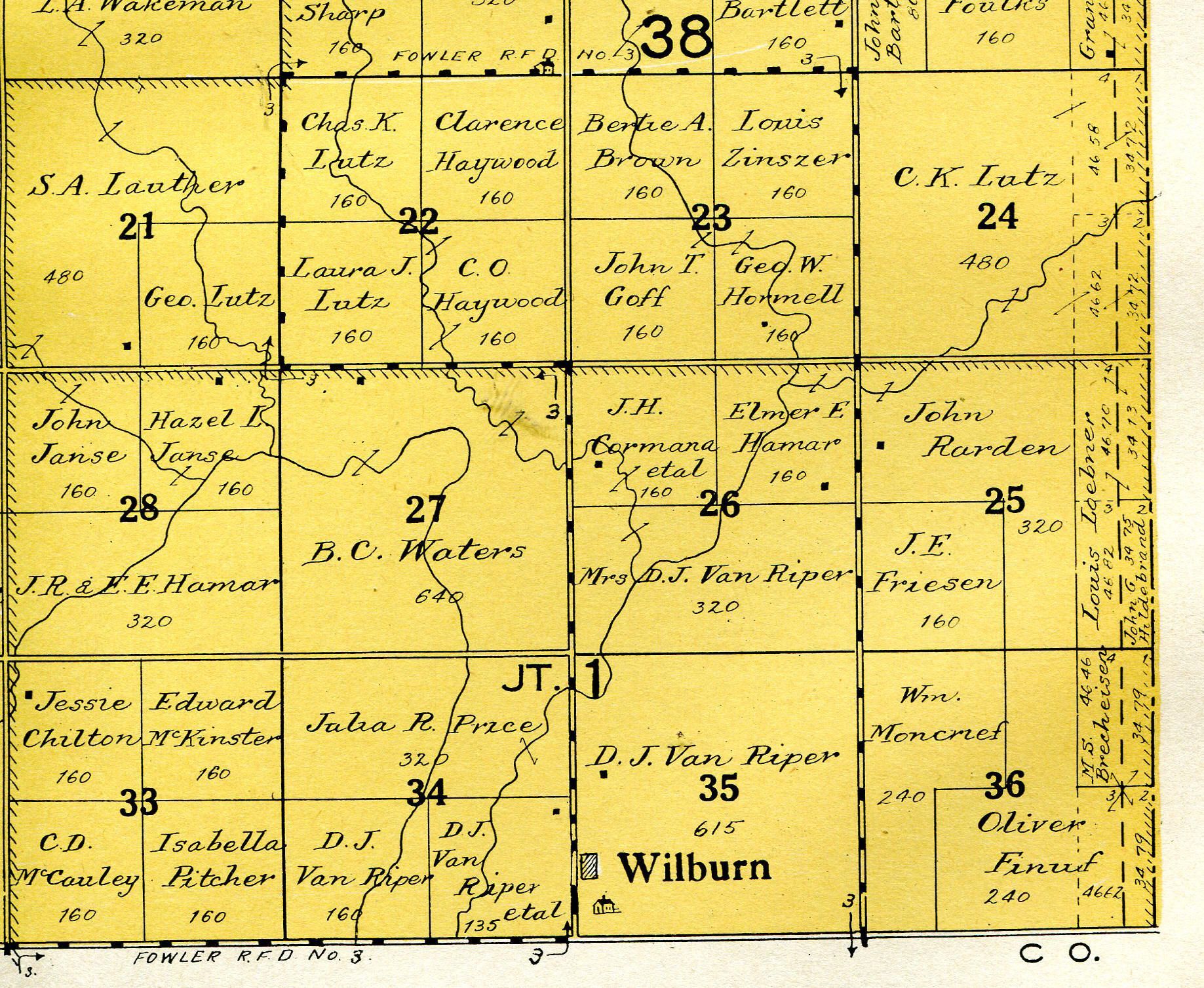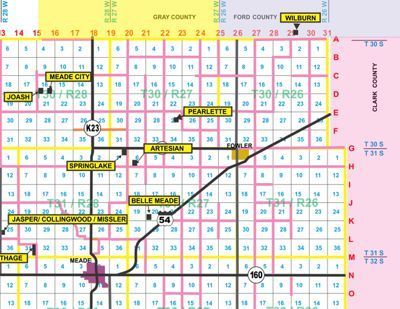Wilburn
The town of Wilburn was actually located in the southern-most part of Ford County in [SW/4-SEC 35-Twp 29-Rng 26]... about a quarter mile from the Ford and Meade County line. Wilburn Cemetery still stands today a quarter mile south and two miles east of the town site [NW/4-SEC 1-Twp 30-Rng 26] in Meade County.
The town site was platted in February, l885, by L. P. Horton and Charles P. Brown. Named after the infant son of Brown, it was situated along Crooked Creek, the first settlement south of Dodge City at the time. Wilburn was an important stop on the Jones & Plummer trail, a supply trail that led from Dodge City to Mobeetie, Texas, used primarily for the transportation of goods by Dodge City merchants. This trail also accommodated Cal Fergurson's stage, which transported people from the end of the railroad in Dodge City to points in Meade County and beyond.
Wilburn's future, however, lay entirely with the prospects of a proposed north-south route of the Chicago, Nebraska, Kansas & Southwestern Railroad running from Redlands, Nebraska to some point in Texas. When this "artery of commerce" failed, Wilburn's future was to be an unrealized dream. But for the moment, its founders, like the rest of those settling southwest Kansas were long on hope and the old Jones & Plummer Trail was enough contact with commerce and the outside world.
(the following is adapted from "On My Fathers Side" by C. Robert Haywood)
In l885, the way to Wilburn as well as to other Meade County hamlets of Fowler, Belle Meade, Meade Center, Spring Lake, Pearlette, and Carthage was the same. One got off the train in Dodge City, bought a ticket at the Dodge House or the Stage Office two doors down, caught the coach at an early 7:00 A.M., and rode as a pampered guest, not on an "old fashioned stage... but on the latest improved-spring cushioned seats," making it as far as Fowler for dinner. None of the towns on Ferguson's swing seemed a better prospect than Wilburn.
The town had achieved a kind of instant, over-night success; booming along with the unlimited prospects of the rest of the mid-l880's land rush. Horton and Brown, the former from Michigan and the latter from Iowa, had built the first store and began selling groceries in April, 1885. Within a year it was a thriving country center. The editor of The Wilburn Argus, Frank Mathews, saw its prospects as better than those of Kansas City or Wichita when they were first established, and a future every bit as fine. Where Fowler in Meade County, Appleton in Clark County and Ryansville in Ford County all had near and contending rivals; Mathews saw none for Wilburn. Apparently Pearlette, even with its post-office, was so insignificant as to deserve no consideration. By mid-summer l885, even the rival editor in Fowler begrudgingly admitted that Wilburn was "quite a little berg."
In April, 1886, editor, Frank Mathews, of The Wilburn Argus reported: We now have a lone hardware, one clothing store, two grocers, a lumberyard, a shoe shop, a larger feed and livery stable, post office, a large will-conducted hotel, a blacksmith shop, and two rustling real estate firms who are always willing to give you any information desired. We also have one of the best schoolhouses in Southwest Kansas, and last but not least a newspaper and publishing office.
From the beginning it was a homesteaders town. It catered to the settlers, that is to say, those "settled" folk who sought the solid support of home and the family virtues of a community already settled down. It was not to have, nor did it desire to have,any wi1d unsettled beginnings such as the old cow-towns had weathered. Frank Mathews testified that it was "a moral town," contrasting favorably with Dodge City by the "conspicuous absence... of the dram shop, gaming hall and their volaries. The western rough has returned to the frontier and the snob of the east has not yet arrived." Wilburn's settlers wanted only stability and opportunity. The kind of society they hoped to fashion was to be a replica of eastern propriety and as near to its cultural pattern as possible.
The establishment of a school was an indication in that direction. The original school had been a modest, incomplete structure with a dirt floor, no desks, only benches for the students. But soon a new school house was built. The school was followed quickly by other manifestations of established respectability: a literary society and an organized baseball team.
J. E. Platt, the State Sunday School Superintendent of the Congregational Church, organized Wilburn's first Sunday School in the spring of 1885, meeting in Theodore Pillow's home. A year later he came back to preach in the school house, praising the congregation's progress and predicting a great future there for the Lord. The Methodist Episcopal Church, however; stole the first march on the other sects and rival congregations when they succeeded in getting the Rev. T.P. Moore assigned to Wilburn; an assignment both the Fowler and Appleton congregations were seeking. The coup was so inspiring that when the Southwest Kansas Conference of the Methodist Church began discussing the site for a new college which was eventually to go to Winfield, Wilburn made a bid for it.
In the summer of 1887, the town reached its peak. The city government was in full operation; business was brisk; new settlers were filing the surrounding claims. The July Fourth celebration of that summer was to be the town's high water mark. Besides the usual picnic and oratory there was to be fireworks and, just like the big cities, a hot-air balloon ascension... representing a town on the rise.
Dreams of Wilburn becoming a metropolis where dashed when the railroad's building plans never materialized. Meanwhile the Rock Island Railroad reached Fowler nine miles southwest of Wilburn on January 31, 1888. The town existed for several more years, but was on a gradual decline. In 1911, the government finally closed the post office.
The school house as a country school remained on well into the lives of the third generation of the original settlers, serving as an educational, social, and community center for box suppers, literary programs, election day polling, and, during the depression, a grim meeting place for AAA and governmental programs.
The rest of the town site was gradually incorporated into the Van Riper acres and after Senator Chester I. Long purchased the land it became part of the "Wilburn Park Farm" with its experimentation with sheep, poultry, and irrigation. Eventually the old store-post office was moved to a neighboring farm to serve as a work shop and, after World War II, efficiency and progress in the guise of school consolidation, even the school house was torn down. Wheat fields have long since claimed the once bright hopes and Wilburn is marked only by history, few with living memory can remember even its decline. The "turn of the Kaleidoscope of time" has been completed.

Map taken from a 1916 Ford County Plat book shows Wilburn as it relates to Ford Co

Modern map of the northeastern most corner of Meade County showing Wilburn just north of Section 2.
VISIT OLD MEADE COUNTY
CONTACT US
Museum:
620.873.2359
info@visitoldmeadecounty.com
200 E.Carthage, Meade, KS
Dalton Gang Hideout:
620.873.2731
daltonhideout@yahoo.com
502 S Pearlette St, Meade, KS
